Deck 5: Elasticity of Demand and Supply
Question
Question
Question
Question
Question
Question
Question
Question
Question
Question
Question
Question
Question
Question
Question
Question
Question
Question
Question
Question
Question
Question
Question
Question
Question
Question
Question
Question
Question
Question
Question
Question
Question
Question
Question
Question
Question
Question
Question
Question
Question
Question
Question
Question
Question
Question
Question
Question
Question
Question
Question
Question
Question
Question
Question
Question
Question
Question
Question
Question
Question
Question
Question
Question
Question
Question
Question
Question
Question
Question
Question
Question
Question
Question
Question
Question
Question
Question
Question
Question

Unlock Deck
Sign up to unlock the cards in this deck!
Unlock Deck
Unlock Deck
1/149
Play
Full screen (f)
Deck 5: Elasticity of Demand and Supply
1
Both the income elasticity of demand and the cross-price elasticity of demand coefficients can take on negative, zero, or positive values.
True
2
The greater the availability of close substitutes for a product, the greater the price elasticity of demand for that product.
True
3
Total revenue is maximized where demand is inelastic.
False
4
If demand is elastic, a decrease in price leads to a decrease in total revenue.

Unlock Deck
Unlock for access to all 149 flashcards in this deck.
Unlock Deck
k this deck
5
Total revenue is the same for every price-quantity combination along a unit-elastic demand curve.

Unlock Deck
Unlock for access to all 149 flashcards in this deck.
Unlock Deck
k this deck
6
Necessities and luxuries are both types of normal goods.

Unlock Deck
Unlock for access to all 149 flashcards in this deck.
Unlock Deck
k this deck
7
Any supply curve that is a straight line passing through the graph's origin is unit elastic.

Unlock Deck
Unlock for access to all 149 flashcards in this deck.
Unlock Deck
k this deck
8
As consumers have a longer time period to respond, the demand for a product typically becomes more inelastic.

Unlock Deck
Unlock for access to all 149 flashcards in this deck.
Unlock Deck
k this deck
9
If demand is inelastic, the percentage change in price is greater than the resulting percentage change in quantity demanded.

Unlock Deck
Unlock for access to all 149 flashcards in this deck.
Unlock Deck
k this deck
10
If the demand curve shifts, but the supply curve does not, and the price remains the same, supply must be perfectly inelastic.

Unlock Deck
Unlock for access to all 149 flashcards in this deck.
Unlock Deck
k this deck
11
Price elasticity is 1 at the midpoint of a linear downward-sloping demand curve.

Unlock Deck
Unlock for access to all 149 flashcards in this deck.
Unlock Deck
k this deck
12
As price decreases along a linear demand curve, the price elasticity of demand decreases.

Unlock Deck
Unlock for access to all 149 flashcards in this deck.
Unlock Deck
k this deck
13
If income rises and the demand for a product remains unchanged, the income elasticity of demand for that product is unit elastic.

Unlock Deck
Unlock for access to all 149 flashcards in this deck.
Unlock Deck
k this deck
14
When the cross-price elasticity of demand between two products is positive, the two goods are said to be substitutes.

Unlock Deck
Unlock for access to all 149 flashcards in this deck.
Unlock Deck
k this deck
15
A normal good is defined as a product for which quantity demanded increases as price decreases.

Unlock Deck
Unlock for access to all 149 flashcards in this deck.
Unlock Deck
k this deck
16
Elasticity rises as price falls along a linear downward-sloping demand curve.

Unlock Deck
Unlock for access to all 149 flashcards in this deck.
Unlock Deck
k this deck
17
The availability of substitutes makes the demand for a good less elastic.

Unlock Deck
Unlock for access to all 149 flashcards in this deck.
Unlock Deck
k this deck
18
The demand for firewood is likely to be more elastic in the summer than in the winter.

Unlock Deck
Unlock for access to all 149 flashcards in this deck.
Unlock Deck
k this deck
19
The larger the proportion of a consumer's budget that is spent on a product, the more the consumer will demand a substitute.

Unlock Deck
Unlock for access to all 149 flashcards in this deck.
Unlock Deck
k this deck
20
The ability of increasing quantity supplied in response to a higher price is identical across industries.

Unlock Deck
Unlock for access to all 149 flashcards in this deck.
Unlock Deck
k this deck
21
Which of the following is assumed to be constant while calculating the price elasticity of demand?
A)The price of the product itself
B)The quantity demanded of the product
C)Total revenue received from the sale of the product
D)The price of all other products
E)The cost of production
A)The price of the product itself
B)The quantity demanded of the product
C)Total revenue received from the sale of the product
D)The price of all other products
E)The cost of production

Unlock Deck
Unlock for access to all 149 flashcards in this deck.
Unlock Deck
k this deck
22
If the price of Pepsi-Cola increases from 40 cents to 50 cents per can and the quantity demanded decreases from 100 cans to 50 cans, then the value of the price elasticity of demand for Pepsi-Cola is:
A)−0.5.
B)−0.25.
C)−1.
D) −3.
E) −2.
A)−0.5.
B)−0.25.
C)−1.
D) −3.
E) −2.

Unlock Deck
Unlock for access to all 149 flashcards in this deck.
Unlock Deck
k this deck
23
Cross-price elasticity measures the responsiveness of the price of good A to a change in the price of good B.

Unlock Deck
Unlock for access to all 149 flashcards in this deck.
Unlock Deck
k this deck
24
If the price elasticity of demand is −0.5, then a:
A)1 percent decrease in quantity demanded leads to a 0.5 percent decrease in price.
B)1 percent decrease in price leads to a 0.5 percent increase in quantity demanded.
C)50 percent decrease in price leads to a 1 percent increase in quantity demanded.
D)50 percent decrease in price leads to a 100 percent increase in quantity demanded.
E)50 percent decrease in quantity demanded leads to a 1 percent decrease in price.
A)1 percent decrease in quantity demanded leads to a 0.5 percent decrease in price.
B)1 percent decrease in price leads to a 0.5 percent increase in quantity demanded.
C)50 percent decrease in price leads to a 1 percent increase in quantity demanded.
D)50 percent decrease in price leads to a 100 percent increase in quantity demanded.
E)50 percent decrease in quantity demanded leads to a 1 percent decrease in price.

Unlock Deck
Unlock for access to all 149 flashcards in this deck.
Unlock Deck
k this deck
25
Unit-elastic demand occurs when:
A)a one-unit increase in price leads to a one-unit decrease in quantity demanded.
B)a 1 percent increase in price leads to a one-unit decrease in quantity demanded.
C)the price elasticity of demand is positive.
D)the price elasticity of demand is exactly zero.
E)the price elasticity of demand is exactly 1.
A)a one-unit increase in price leads to a one-unit decrease in quantity demanded.
B)a 1 percent increase in price leads to a one-unit decrease in quantity demanded.
C)the price elasticity of demand is positive.
D)the price elasticity of demand is exactly zero.
E)the price elasticity of demand is exactly 1.

Unlock Deck
Unlock for access to all 149 flashcards in this deck.
Unlock Deck
k this deck
26
Table 5.2 shows the change in the quantity demanded for Good A and Good B as a result of the change in their price. Use the information in the table below to calculate the price elasticity of demand for Good A. Table 5.2
Quantity
Price
Good A
100
$10
120
$ 9
Good B
200
$20
140
$35
A)−5/2
B)−11/3
C)−3/10
D)−10/3
E)−19/11
Quantity
Price
Good A
100
$10
120
$ 9
Good B
200
$20
140
$35
A)−5/2
B)−11/3
C)−3/10
D)−10/3
E)−19/11

Unlock Deck
Unlock for access to all 149 flashcards in this deck.
Unlock Deck
k this deck
27
Another word for elasticity is _____.
A)responsiveness
B)happiness
C)bonus
D)profit
E)surplus
A)responsiveness
B)happiness
C)bonus
D)profit
E)surplus

Unlock Deck
Unlock for access to all 149 flashcards in this deck.
Unlock Deck
k this deck
28
Demand is inelastic if:
A)the percentage change in price is greater than the percentage change in quantity demanded.
B)the percentage change in price is less than the percentage change in quantity demanded.
C)the percentage change in price is equal to the percentage change in quantity demanded.
D)the value of price elasticity is equal to −1.
E)the value of price elasticity is less than −1.
A)the percentage change in price is greater than the percentage change in quantity demanded.
B)the percentage change in price is less than the percentage change in quantity demanded.
C)the percentage change in price is equal to the percentage change in quantity demanded.
D)the value of price elasticity is equal to −1.
E)the value of price elasticity is less than −1.

Unlock Deck
Unlock for access to all 149 flashcards in this deck.
Unlock Deck
k this deck
29
If an increase in the price of a product from $1 to $2 per unit leads to a decrease in the quantity demanded from 100 to 80 units, then the value of the price elasticity of demand is:
A)−1/3
B)−2 1/3
C)−1/4
D)−3
E)−2/3
A)−1/3
B)−2 1/3
C)−1/4
D)−3
E)−2/3

Unlock Deck
Unlock for access to all 149 flashcards in this deck.
Unlock Deck
k this deck
30
Table 5.3 shows the quantity supplied and the quantity demanded for restaurant meals at different prices. Use the information in the table below to calculate the value of the price elasticity of demand for restaurant meals. Table 5.3

A)−1/2
B)−5/3
C)−3/5
D)−3/7
E)−7/3

A)−1/2
B)−5/3
C)−3/5
D)−3/7
E)−7/3

Unlock Deck
Unlock for access to all 149 flashcards in this deck.
Unlock Deck
k this deck
31
The price elasticity of demand is useful because it measures the responsiveness of _____ to changes in _____.
A)taxpayers; demand
B)producers; supply
C)consumers; price
D)consumers; demand
E)producers; income
A)taxpayers; demand
B)producers; supply
C)consumers; price
D)consumers; demand
E)producers; income

Unlock Deck
Unlock for access to all 149 flashcards in this deck.
Unlock Deck
k this deck
32
The price elasticity of demand is typically negative because:
A)as price decreases, quantity demanded decreases.
B)as price decreases, quantity demanded increases.
C)as price decreases, demand decreases.
D)as price decreases, demand increases.
E)consumers rarely respond to a change in price.
A)as price decreases, quantity demanded decreases.
B)as price decreases, quantity demanded increases.
C)as price decreases, demand decreases.
D)as price decreases, demand increases.
E)consumers rarely respond to a change in price.

Unlock Deck
Unlock for access to all 149 flashcards in this deck.
Unlock Deck
k this deck
33
Demand is inelastic only if the price elasticity of demand has an absolute value:
A)of 1.
B)greater than 1.
C)greater than 0 but less than 1.
D)greater than 0.
E)greater than 5.
A)of 1.
B)greater than 1.
C)greater than 0 but less than 1.
D)greater than 0.
E)greater than 5.

Unlock Deck
Unlock for access to all 149 flashcards in this deck.
Unlock Deck
k this deck
34
Elasticity measures:
A)whether a price increase causes quantity demanded to increase or decrease.
B)the strength of an economy's tendency to recover from recession.
C)the responsiveness of decision makers to changes in price, income, or other variables.
D)the profitability of investment in an industry.
E)the long-run price trends in an economy.
A)whether a price increase causes quantity demanded to increase or decrease.
B)the strength of an economy's tendency to recover from recession.
C)the responsiveness of decision makers to changes in price, income, or other variables.
D)the profitability of investment in an industry.
E)the long-run price trends in an economy.

Unlock Deck
Unlock for access to all 149 flashcards in this deck.
Unlock Deck
k this deck
35
Demand is unit elastic whenever
A)price elasticity has an absolute value of 1.
B)price elasticity has an absolute value greater than 1.
C)price elasticity has an absolute value less than 1.
D)price elasticity is negative.
E)consumers do not respond to a change in price.
A)price elasticity has an absolute value of 1.
B)price elasticity has an absolute value greater than 1.
C)price elasticity has an absolute value less than 1.
D)price elasticity is negative.
E)consumers do not respond to a change in price.

Unlock Deck
Unlock for access to all 149 flashcards in this deck.
Unlock Deck
k this deck
36
The price elasticity of demand is defined as:
A)the percentage change in price divided by the percentage change in quantity demanded.
B)the percentage change in quantity demanded divided by the percentage change in price.
C)the change in quantity demanded divided by the change in price.
D)the change in price divided by the change in quantity demanded.
E)the quantity demanded divided by the price.
A)the percentage change in price divided by the percentage change in quantity demanded.
B)the percentage change in quantity demanded divided by the percentage change in price.
C)the change in quantity demanded divided by the change in price.
D)the change in price divided by the change in quantity demanded.
E)the quantity demanded divided by the price.

Unlock Deck
Unlock for access to all 149 flashcards in this deck.
Unlock Deck
k this deck
37
The price elasticity of demand is calculated as:
A)the percentage change in quantity demanded divided by the percentage change in price.
B)the percentage change in price divided by the percentage change in quantity demanded.
C)the absolute change in quantity demanded divided by the absolute change in price.
D)the absolute change in price divided by the absolute change in quantity demanded.
E)price multiplied by quantity demanded at that price.
A)the percentage change in quantity demanded divided by the percentage change in price.
B)the percentage change in price divided by the percentage change in quantity demanded.
C)the absolute change in quantity demanded divided by the absolute change in price.
D)the absolute change in price divided by the absolute change in quantity demanded.
E)price multiplied by quantity demanded at that price.

Unlock Deck
Unlock for access to all 149 flashcards in this deck.
Unlock Deck
k this deck
38
Table 5.1 shows the change in the quantity demanded for a product as a result of a change in the price of the product. Use the information in the table below to calculate the value of the price elasticity of demand. Table 5.1
Quantity
Price
Old
20
$40
New
10
$60
A)−2/3
B)−1/3
C)−3/5
D) −5/3
E)0
Quantity
Price
Old
20
$40
New
10
$60
A)−2/3
B)−1/3
C)−3/5
D) −5/3
E)0

Unlock Deck
Unlock for access to all 149 flashcards in this deck.
Unlock Deck
k this deck
39
Substitutes are pairs of goods that have a positive cross-price elasticity of demand.

Unlock Deck
Unlock for access to all 149 flashcards in this deck.
Unlock Deck
k this deck
40
Table 5.2 shows the change in the quantity demanded for Good A and Good B as a result of the change in their price. Use the information in the table below to calculate the value of the price elasticity of demand for Good B. Table 5.2
Quantity
Price
Good A
100
$10
120
$ 9
Good B
200
$20
140
$35
A)−2/3
B)−1/6
C)−1/2
D)−11/17
E)−17/11
Quantity
Price
Good A
100
$10
120
$ 9
Good B
200
$20
140
$35
A)−2/3
B)−1/6
C)−1/2
D)−11/17
E)−17/11

Unlock Deck
Unlock for access to all 149 flashcards in this deck.
Unlock Deck
k this deck
41
If a 5 percent increase in price leads to an 8 percent decrease in quantity demanded, demand is:
A)perfectly elastic.
B)elastic.
C)unit elastic.
D)inelastic.
E)perfectly inelastic.
A)perfectly elastic.
B)elastic.
C)unit elastic.
D)inelastic.
E)perfectly inelastic.

Unlock Deck
Unlock for access to all 149 flashcards in this deck.
Unlock Deck
k this deck
42
Suppose consumers spent $42 million on Christmas trees last year, when the average tree cost was $30. This year they spend $42 million, when the average tree costs $25. Assume that everything else remains constant. This data suggests that:
A)consumers bought the same number of Christmas trees this year as last year.
B)the price of the Christmas trees stayed the same.
C)total revenue to tree producers rose this year.
D)the demand for trees is unit elastic.
E)the demand for trees is inelastic.
A)consumers bought the same number of Christmas trees this year as last year.
B)the price of the Christmas trees stayed the same.
C)total revenue to tree producers rose this year.
D)the demand for trees is unit elastic.
E)the demand for trees is inelastic.

Unlock Deck
Unlock for access to all 149 flashcards in this deck.
Unlock Deck
k this deck
43
A government-imposed price floor above the market price of milk would increase consumers' expenditures on milk only if _____.
A)demand is elastic
B)supply is inelastic
C)demand falls
D)demand is inelastic
E)supply is unit elastic
A)demand is elastic
B)supply is inelastic
C)demand falls
D)demand is inelastic
E)supply is unit elastic

Unlock Deck
Unlock for access to all 149 flashcards in this deck.
Unlock Deck
k this deck
44
Which of the following determines a firm's revenue when it changes the price of its product?
A)The firm's cost function
B)The elasticity of the firm's total product curve
C)The plant size used by the firm in the long run
D)The price elasticity of demand for the firm's product
E)The price elasticity of supply
A)The firm's cost function
B)The elasticity of the firm's total product curve
C)The plant size used by the firm in the long run
D)The price elasticity of demand for the firm's product
E)The price elasticity of supply

Unlock Deck
Unlock for access to all 149 flashcards in this deck.
Unlock Deck
k this deck
45
If demand is price elastic, total revenue is:
A)directly related to quantity demanded.
B)inversely related to quantity demanded.
C)directly related to price.
D)directly related to price and inversely related to quantity demanded.
E)not related to either price or to quantity demanded.
A)directly related to quantity demanded.
B)inversely related to quantity demanded.
C)directly related to price.
D)directly related to price and inversely related to quantity demanded.
E)not related to either price or to quantity demanded.

Unlock Deck
Unlock for access to all 149 flashcards in this deck.
Unlock Deck
k this deck
46
When agricultural production increases, the total amount paid for agricultural products tends to:
A)increase because demand is perfectly elastic.
B)decrease because demand is price elastic.
C)increase because demand is price inelastic.
D)decrease because demand is price inelastic.
E)remain constant because demand is price inelastic.
A)increase because demand is perfectly elastic.
B)decrease because demand is price elastic.
C)increase because demand is price inelastic.
D)decrease because demand is price inelastic.
E)remain constant because demand is price inelastic.

Unlock Deck
Unlock for access to all 149 flashcards in this deck.
Unlock Deck
k this deck
47
A university administration's decision to raise tuition in order to increase revenue will be successful if:
A)the demand curve slopes downward.
B)demand is elastic.
C)demand is inelastic.
D)supply is elastic.
E)supply is inelastic.
A)the demand curve slopes downward.
B)demand is elastic.
C)demand is inelastic.
D)supply is elastic.
E)supply is inelastic.

Unlock Deck
Unlock for access to all 149 flashcards in this deck.
Unlock Deck
k this deck
48
The demand for a good is elastic if:
A)an increase in price leads to a decrease in total revenue.
B)an increase in price leads to an increase in total revenue.
C)an increase in price causes no change in total revenue.
D)a decrease in price causes no changes in total revenue.
E)a decrease in price leads to a decrease in total revenue.
A)an increase in price leads to a decrease in total revenue.
B)an increase in price leads to an increase in total revenue.
C)an increase in price causes no change in total revenue.
D)a decrease in price causes no changes in total revenue.
E)a decrease in price leads to a decrease in total revenue.

Unlock Deck
Unlock for access to all 149 flashcards in this deck.
Unlock Deck
k this deck
49
If an increase in the price of a product from $100 to $200 per unit leads to a decrease in the quantity demanded from 10 to 8 units, then demand is:
A)elastic.
B)inelastic.
C)unit elastic.
D)zero.
E)perfectly elastic.
A)elastic.
B)inelastic.
C)unit elastic.
D)zero.
E)perfectly elastic.

Unlock Deck
Unlock for access to all 149 flashcards in this deck.
Unlock Deck
k this deck
50
The price elasticity of demand for milk when quantity is measured in gallons will be _____ the price elasticity when quantity is measured in quarts.
A)the same as
B)four times
C)one-fourth of
D)two times
E)less than
A)the same as
B)four times
C)one-fourth of
D)two times
E)less than

Unlock Deck
Unlock for access to all 149 flashcards in this deck.
Unlock Deck
k this deck
51
The price elasticity of demand helps determine the effect of price changes on a firm's:
A)property tax.
B)profit.
C)total output.
D)revenue.
E)total cost.
A)property tax.
B)profit.
C)total output.
D)revenue.
E)total cost.

Unlock Deck
Unlock for access to all 149 flashcards in this deck.
Unlock Deck
k this deck
52
Elasticity is always _____.
A)measured in dollars
B)measured in utils
C)measured in units of quantity
D)measured in pounds
E)independent of the units of measurement for price and quantity
A)measured in dollars
B)measured in utils
C)measured in units of quantity
D)measured in pounds
E)independent of the units of measurement for price and quantity

Unlock Deck
Unlock for access to all 149 flashcards in this deck.
Unlock Deck
k this deck
53
Table 5.4 shows the price and quantity combinations for a product. The demand for the good is _____, and an increase in the price of the product from $40 to $60 per unit will _____ total revenue. Table 5.4

A)unit elastic; increase
B)elastic; decrease
C)unit elastic; not change
D)inelastic; increase
E)elastic; decrease

A)unit elastic; increase
B)elastic; decrease
C)unit elastic; not change
D)inelastic; increase
E)elastic; decrease

Unlock Deck
Unlock for access to all 149 flashcards in this deck.
Unlock Deck
k this deck
54
If an increase in the price of a product from $1 to $2 per unit leads to a decrease in the quantity demanded from 100 to 80 units, then the demand is:
A)elastic.
B)inelastic.
C)unit elastic.
D)perfectly elastic.
E)perfectly inelastic.
A)elastic.
B)inelastic.
C)unit elastic.
D)perfectly elastic.
E)perfectly inelastic.

Unlock Deck
Unlock for access to all 149 flashcards in this deck.
Unlock Deck
k this deck
55
If the price of Pepsi-Cola increases from 50 cents to 60 cents per can and the quantity demanded decreases from 100 cans to 50 cans, then the demand for Pepsi-Cola is:
A)unit elastic.
B)perfectly elastic.
C)perfectly inelastic.
D)elastic.
E)inelastic.
A)unit elastic.
B)perfectly elastic.
C)perfectly inelastic.
D)elastic.
E)inelastic.

Unlock Deck
Unlock for access to all 149 flashcards in this deck.
Unlock Deck
k this deck
56
Wheat farmers in Kansas would benefit from a devastating crop failure in North Dakota (another major wheat-producing state) if the U.S. demand for wheat is:
A)inelastic.
B)elastic.
C)unit elastic.
D)downward sloping.
E)perfectly elastic.
A)inelastic.
B)elastic.
C)unit elastic.
D)downward sloping.
E)perfectly elastic.

Unlock Deck
Unlock for access to all 149 flashcards in this deck.
Unlock Deck
k this deck
57
If demand is unit elastic, a price reduction will:
A)increase revenues.
B)reduce revenues.
C)reduce total cost.
D)have no effect on revenues.
E)increase profits.
A)increase revenues.
B)reduce revenues.
C)reduce total cost.
D)have no effect on revenues.
E)increase profits.

Unlock Deck
Unlock for access to all 149 flashcards in this deck.
Unlock Deck
k this deck
58
If a price reduction leads to an increase in total revenue, demand is:
A)perfectly inelastic.
B)inelastic.
C)unit elastic.
D)elastic.
E)perfectly elastic.
A)perfectly inelastic.
B)inelastic.
C)unit elastic.
D)elastic.
E)perfectly elastic.

Unlock Deck
Unlock for access to all 149 flashcards in this deck.
Unlock Deck
k this deck
59
If a firm raises the price of its product, its total revenue will:
A)always increase.
B)increase only if demand is price inelastic.
C)increase only if demand is price elastic.
D)remain constant regardless of the price elasticity of demand.
E)never increase.
A)always increase.
B)increase only if demand is price inelastic.
C)increase only if demand is price elastic.
D)remain constant regardless of the price elasticity of demand.
E)never increase.

Unlock Deck
Unlock for access to all 149 flashcards in this deck.
Unlock Deck
k this deck
60
If city officials expect that an increase in bus fares will raise mass transit revenues, they must think that the demand for bus travel is _____.
A)elastic
B)unit elastic
C)inelastic
D)upward-sloping
E)perfectly elastic
A)elastic
B)unit elastic
C)inelastic
D)upward-sloping
E)perfectly elastic

Unlock Deck
Unlock for access to all 149 flashcards in this deck.
Unlock Deck
k this deck
61
One group of people uses New York City subways only during rush hour to travel to and from work. Another group uses them only in midday for leisure activity. If New York City wants to increase transit fares with the smallest possible reduction in revenue, for which group should it increase the fare?
A)The rush-hour group because its demand for subway service is more elastic than that of the midday group.
B)The rush-hour group because its demand for subway service is less elastic than that of the midday group.
C)The midday group because its demand for subway service is more elastic than that of the rush-hour group.
D)The midday group because its demand for subway service is less elastic than that of the rush-hour group.
E)It doesn't matter because both groups have the same elasticity of demand.
A)The rush-hour group because its demand for subway service is more elastic than that of the midday group.
B)The rush-hour group because its demand for subway service is less elastic than that of the midday group.
C)The midday group because its demand for subway service is more elastic than that of the rush-hour group.
D)The midday group because its demand for subway service is less elastic than that of the rush-hour group.
E)It doesn't matter because both groups have the same elasticity of demand.

Unlock Deck
Unlock for access to all 149 flashcards in this deck.
Unlock Deck
k this deck
62
Figure 5.4 shows a downward-sloping linear demand curve. Which of the following is true between points g and h in the figure below?
Figure 5.4
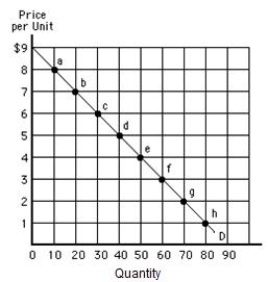
A)Total revenue remains constant at $180
B)Total revenue falls by $12.
C)Total revenue falls by $60.
D)Total revenue falls by $180.
E)Total revenue increases by $300.
Figure 5.4

A)Total revenue remains constant at $180
B)Total revenue falls by $12.
C)Total revenue falls by $60.
D)Total revenue falls by $180.
E)Total revenue increases by $300.

Unlock Deck
Unlock for access to all 149 flashcards in this deck.
Unlock Deck
k this deck
63
Figure 5.3 shows a linear demand curve. As you move from point A to point B along the demand curve, total revenue _____ and the demand is _____.
Figure 5.3
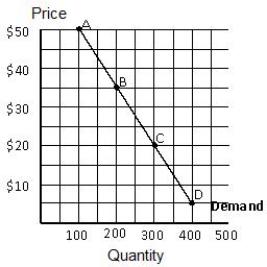
A)stays the same; unitary
B)decreases; inelastic
C)increases; elastic
D)increases; elastic
E)increases, inelastic
Figure 5.3

A)stays the same; unitary
B)decreases; inelastic
C)increases; elastic
D)increases; elastic
E)increases, inelastic

Unlock Deck
Unlock for access to all 149 flashcards in this deck.
Unlock Deck
k this deck
64
Figure 5.5 shows the total revenue curve for a firm. Which of the following statements is true in the range of the total revenue curve labeled A?
Figure 5.5
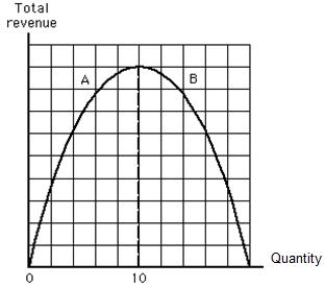
A)Demand is elastic.
B)Demand is inelastic.
C)Demand is unit elastic.
D)Demand is perfectly inelastic.
E)Demand is perfectly elastic.
Figure 5.5

A)Demand is elastic.
B)Demand is inelastic.
C)Demand is unit elastic.
D)Demand is perfectly inelastic.
E)Demand is perfectly elastic.

Unlock Deck
Unlock for access to all 149 flashcards in this deck.
Unlock Deck
k this deck
65
Figure 5.1 shows the demand curve for a firm. In the figure below, the total revenue at point a is _____. Figure 5.1
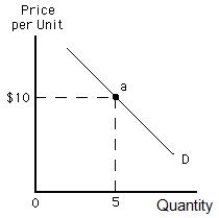
A)$4
B)$5
C)$10
D)$50
E)$100

A)$4
B)$5
C)$10
D)$50
E)$100

Unlock Deck
Unlock for access to all 149 flashcards in this deck.
Unlock Deck
k this deck
66
Suppose the price elasticity of demand for your economics textbook is −1. If the publisher raises the price by 5 percent:
A)revenues will rise by 5 percent.
B)quantity demanded will rise by 5 percent.
C)total revenue will not change.
D)revenues will fall.
E)revenues will fall by 5 percent.
A)revenues will rise by 5 percent.
B)quantity demanded will rise by 5 percent.
C)total revenue will not change.
D)revenues will fall.
E)revenues will fall by 5 percent.

Unlock Deck
Unlock for access to all 149 flashcards in this deck.
Unlock Deck
k this deck
67
The total revenue curve that corresponds to a downward-sloping linear demand curve:
A)slopes downward.
B)slopes upward.
C)is a horizontal line.
D)first rises, then falls.
E)first falls, then rises.
A)slopes downward.
B)slopes upward.
C)is a horizontal line.
D)first rises, then falls.
E)first falls, then rises.

Unlock Deck
Unlock for access to all 149 flashcards in this deck.
Unlock Deck
k this deck
68
Along a linear demand curve, as the price increases from zero:
A)demand decreases.
B)demand increases.
C)quantity demanded increases.
D)total revenue first increases but eventually decreases.
E)total revenue first decreases but eventually increases.
A)demand decreases.
B)demand increases.
C)quantity demanded increases.
D)total revenue first increases but eventually decreases.
E)total revenue first decreases but eventually increases.

Unlock Deck
Unlock for access to all 149 flashcards in this deck.
Unlock Deck
k this deck
69
Figure 5.5 shows the total revenue curve for a firm. Which of the following statements is true in the range of the total revenue curve labeled B?
Figure 5.5.
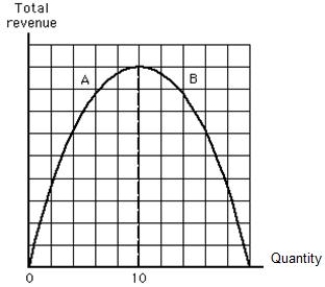
A)Demand is elastic.
B)Demand is inelastic.
C)Demand is unit elastic.
D)Demand is perfectly inelastic.
E)Demand is perfectly elastic.
Figure 5.5.

A)Demand is elastic.
B)Demand is inelastic.
C)Demand is unit elastic.
D)Demand is perfectly inelastic.
E)Demand is perfectly elastic.

Unlock Deck
Unlock for access to all 149 flashcards in this deck.
Unlock Deck
k this deck
70
Figure 5.2 shows a demand curve. D, the demand curve in the figure below is an example of a(n):
Figure 5.2.
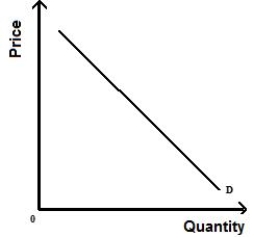
A)upward-sloping demand curve.
B)linear demand curve.
C)perfectly elastic demand curve.
D)unit-elastic demand curve.
E)perfectly inelastic demand curve.
Figure 5.2.

A)upward-sloping demand curve.
B)linear demand curve.
C)perfectly elastic demand curve.
D)unit-elastic demand curve.
E)perfectly inelastic demand curve.

Unlock Deck
Unlock for access to all 149 flashcards in this deck.
Unlock Deck
k this deck
71
Identify a statement that is true about a linear demand curve.
A)Along a linear demand curve, both the slope and price elasticity are constant.
B)Along a linear demand curve, the price elasticity is constant, but the slope varies.
C)Along a linear demand curve, total revenues are constant.
D)Along a linear demand curve, the slope is constant, but the price elasticity varies.
E) Along a linear demand curve, total revenues are negative.
A)Along a linear demand curve, both the slope and price elasticity are constant.
B)Along a linear demand curve, the price elasticity is constant, but the slope varies.
C)Along a linear demand curve, total revenues are constant.
D)Along a linear demand curve, the slope is constant, but the price elasticity varies.
E) Along a linear demand curve, total revenues are negative.

Unlock Deck
Unlock for access to all 149 flashcards in this deck.
Unlock Deck
k this deck
72
Figure 5.4 shows a downward-sloping linear demand curve. Between points b and c in the figure below, price decreases by $1, quantity demanded increases by 10, _____.
Figure 5.4
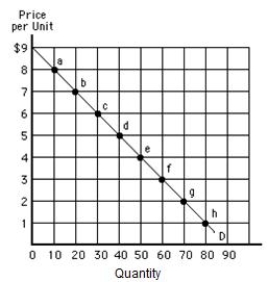
A)total revenue decreases by $1, and demand is elastic
B)total revenue decreases by $1, and demand is inelastic
C)total revenue increases by $40, and demand is elastic
D)total revenue increases by $40, and demand is inelastic
E)and total revenue increases by $80
Figure 5.4

A)total revenue decreases by $1, and demand is elastic
B)total revenue decreases by $1, and demand is inelastic
C)total revenue increases by $40, and demand is elastic
D)total revenue increases by $40, and demand is inelastic
E)and total revenue increases by $80

Unlock Deck
Unlock for access to all 149 flashcards in this deck.
Unlock Deck
k this deck
73
The total revenue from selling trucks is equal to:
A)the price of a truck times the quantity sold.
B)the change in quantity sold divided by the change in price.
C)average cost times the quantity produced.
D)the price of a truck times the quantity produced.
E)the price of a truck times the price elasticity of demand.
A)the price of a truck times the quantity sold.
B)the change in quantity sold divided by the change in price.
C)average cost times the quantity produced.
D)the price of a truck times the quantity produced.
E)the price of a truck times the price elasticity of demand.

Unlock Deck
Unlock for access to all 149 flashcards in this deck.
Unlock Deck
k this deck
74
Which of the following statements is not true?
A)A perfectly elastic demand curve is a constant-elasticity demand curve.
B)A linear demand curve with a slope of −4 is a constant-elasticity demand curve.
C)A perfectly inelastic demand curve is a constant-elasticity demand curve.
D)Total revenue increases along a unit-elastic demand curve.
E)The elasticity value for a perfectly elastic demand curve is zero.
A)A perfectly elastic demand curve is a constant-elasticity demand curve.
B)A linear demand curve with a slope of −4 is a constant-elasticity demand curve.
C)A perfectly inelastic demand curve is a constant-elasticity demand curve.
D)Total revenue increases along a unit-elastic demand curve.
E)The elasticity value for a perfectly elastic demand curve is zero.

Unlock Deck
Unlock for access to all 149 flashcards in this deck.
Unlock Deck
k this deck
75
Figure 5.3 shows a linear demand curve. Between points A and B, the demand is:
Figure 5.3
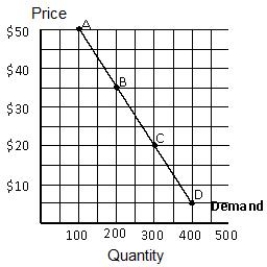
A)unitary.
B)elastic.
C)inelastic.
D)perfectly elastic.
E)perfectly inelastic.
Figure 5.3

A)unitary.
B)elastic.
C)inelastic.
D)perfectly elastic.
E)perfectly inelastic.

Unlock Deck
Unlock for access to all 149 flashcards in this deck.
Unlock Deck
k this deck
76
Figure 5.3 shows a linear demand curve. As you move from point B to point C along the demand curve, total revenue _____ and the demand is _____.
Figure 5.3
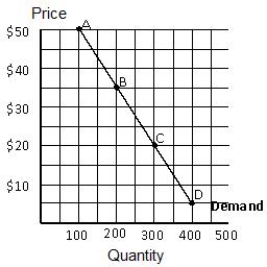
A)stays the same; unitary
B)decreases; inelastic
C)increases; elastic
D)decreases; elastic
E)increases, inelastic
Figure 5.3

A)stays the same; unitary
B)decreases; inelastic
C)increases; elastic
D)decreases; elastic
E)increases, inelastic

Unlock Deck
Unlock for access to all 149 flashcards in this deck.
Unlock Deck
k this deck
77
Figure 5.5 shows the total revenue curve for a firm. Which of the following statements is true at a quantity of 10?
Figure 5.5
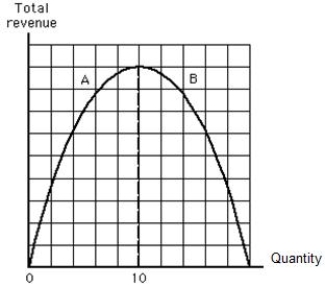
A)Demand is elastic.
B)Demand is inelastic.
C)Demand is unit elastic.
D)Demand is perfectly inelastic.
E)Demand is perfectly elastic.
Figure 5.5

A)Demand is elastic.
B)Demand is inelastic.
C)Demand is unit elastic.
D)Demand is perfectly inelastic.
E)Demand is perfectly elastic.

Unlock Deck
Unlock for access to all 149 flashcards in this deck.
Unlock Deck
k this deck
78
Which of the following describes a situation in which demand must be inelastic?
A)Total revenue decreases by 10 percent when the price of spats rises by 10 percent.
B)Total revenue decreases by less than 10 percent when the price of spats rises by 10 percent.
C)Total revenue increases by more than 10 percent when the price of spats rises by 10 percent.
D)Total revenue decreases by $10 when the price of spats rises by $10.
E)Total revenue decreases by more than $10 when the price of spats rises by $10.
A)Total revenue decreases by 10 percent when the price of spats rises by 10 percent.
B)Total revenue decreases by less than 10 percent when the price of spats rises by 10 percent.
C)Total revenue increases by more than 10 percent when the price of spats rises by 10 percent.
D)Total revenue decreases by $10 when the price of spats rises by $10.
E)Total revenue decreases by more than $10 when the price of spats rises by $10.

Unlock Deck
Unlock for access to all 149 flashcards in this deck.
Unlock Deck
k this deck
79
Figure 5.3 shows a linear demand curve. Between points B and C, the demand is:
Figure 5.3

A)unitary.
B)elastic.
C)inelastic.
D)perfectly elastic.
E)perfectly inelastic.
Figure 5.3

A)unitary.
B)elastic.
C)inelastic.
D)perfectly elastic.
E)perfectly inelastic.

Unlock Deck
Unlock for access to all 149 flashcards in this deck.
Unlock Deck
k this deck
80
Figure 5.3 shows a linear demand curve. Between points C and D, the demand is:
Figure 5.3
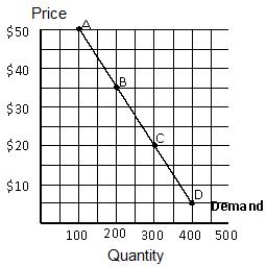
A)unitary.
B)elastic.
C)inelastic.
D)perfectly elastic.
E)perfectly inelastic.
Figure 5.3

A)unitary.
B)elastic.
C)inelastic.
D)perfectly elastic.
E)perfectly inelastic.

Unlock Deck
Unlock for access to all 149 flashcards in this deck.
Unlock Deck
k this deck



